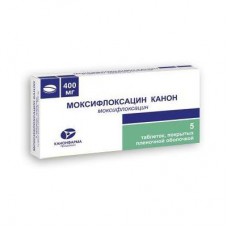Expiration date: 09/2026
Release form
Tablets, film-coated yellow color, oval, lenticular, cross cut - light yellow color.
Packaging
5 PCs. - packaging sells contoured (aluminium/PVC) (1) - packs of cardboard.
Pharmacological action
Antimicrobial agent of the fluoroquinolone group, has bactericidal. Shows activity against wide range of gram-positive and gram-negative microorganisms, anaerobic, acid-resistant and atypical bacteria: Mycoplasma spp., Chlamydia spp., Legionella spp. Effective against bacterial strains resistant to beta-lactams and macrolides. Active against most strains of microorganisms: gram positive - Staphylococcus aureus (including strains sensitive to methicillin), Streptococcus pneumoniae (including strains resistant to penicillin and macrolides), Streptococcus pyogenes (group a), gram-negative - Haemophilus influenzae (including producing and not producing beta-lactamase strains), Haemophilus parainfluenzae, Klebsiella pneumoniae, Moraxella catarrhalis (including producing and not producing beta-lactamase strains), Escherichia coli, Enterobacter cloacae, atypical - Chlamydia pneumoniae, Mycoplasma pneumoniae. According to in vitro studies, while the following organisms are sensitive to moxifloxacin, however, the safety and efficacy for treatment of infections has not been established. Gram-positive microorganisms: Streptococcus milleri, Streptococcus mitior, Streptococcus agalactiae, Streptococcus dysgalactiae, Staphylococcus cohnii, Staphylococcus epidermidis (including strains sensitive to methicillin), Staphylococcus haemolyticus, Staphylococcus hominis, Staphylococcus saprophyticus, Staphylococcus simulans, Corynebacterium diphtheriae. Gram-negative microorganisms: Bordetella pertussis, Klebsiella oxytoca, Enterobacter aerogenes, Enterobacter agglomerans, Enterobacter Intermedius, Enterobacter sakazaki, Proteus mirabilis, Proteus vulgaris, Morganella morganii, Providencia rettgeri, Providencia stuartii. Anaerobic microorganisms: Bacteroides distasonis, Bacteroides eggerthii, Bacteroides fragilis, Bacteroides ovatus, Bacteroides thetaiotaornicron, Bacteroides uniformis, Fusobacterium spp., Porphyromonas spp., Porphyromonas anaerobius, Porphyromonas asaccharolyticus, Porphyromonas magnus, Prevotella spp., Propionibacterium spp., Clostridium perfringens, Clostridium ramosum. Atypical organisms: Legionella pneumophila, Caxiella burnettii.
Topoisomerase blocks II and IV, enzymes that control the topological properties of DNA, and are involved in replication, repair and transcription of DNA. The effect of moxifloxacin depend on its concentration in the blood and tissues. Minimum bactericidal concentrations do not differ from the minimum inhibitory concentrations.
Mechanisms of development of resistance, inactivating penicillins, cephalosporins, aminoglycosides, macrolides and tetracyclines do not affect the antibacterial activity of moxifloxacin. Cross-resistance between moxifloxacin and these drugs missing. Plasmid-mediated mechanism of development of resistance was not observed. The overall frequency of developing resistance is low. In vitro studies showed that resistance to moxifloxacin develops slowly as a result of several successive mutations. With repeated exposure to the microorganisms of the suppressive subminimal moxifloxacin in concentrations only slightly increases performance of the IPC. Between the drugs of the fluoroquinolone group observed cross-resistance. However, some gram-positive and anaerobic organisms resistant to other fluoroquinolones that are sensitive to moxifloxacin.
Pharmacokinetics
After intake moxifloxacin is absorbed rapidly and almost completely. After a single dose of moxifloxacin in a dose of 400 mg Cmax in the blood is achieved within 0.5-4 h and is 3.1 mg/L.
After a single infusion at a dose of 400 mg for 1 h, Cmax is reached at the end of the infusion and is 4.1 mg/l, which corresponds to its increase by approximately 26% compared to the value of this index by ingestion. With repeated on/in the infusion at a dose of 400 mg 1 h Cmax varies in the range from 4.1 mg/l to 5.9 mg/l. Average Css, equal to 4.4 mg/l, achieved at the end of the infusion.
The absolute bioavailability of approximately 91%.
The pharmacokinetics of moxifloxacin when used in single doses of 50 mg to 1200 mg, and a dose of 600 mg/day for 10 days is linear.
The equilibrium state is reached within 3 days.
Linking blood protein (mainly to albumin) is about 45%.
Moxifloxacin is rapidly distributed to organs and tissues. Vd is approximately 2 l/kg.
High concentration of moxifloxacin, exceeding those in the plasma are created in the lung tissue (alveolar macrophages) in the mucosa of the bronchi, sinuses, soft tissue, skin and subcutaneous structures, foci of inflammation. In the interstitial fluid and in the saliva of the drug is determined in a free, not associated with the protein form, in concentrations higher than in plasma. In addition, the high concentration of active substances are determined in the abdominal organs and peritoneal fluids, and in tissues of the female genital organs.
Biotransformiroetsa to the inactive sulfasalizine and glucuronides. Moxifloxacin is not subject to biotransformation by liver microsomal enzymes of cytochrome P450.
After passing the 2nd phase of biotransformation moxifloxacin is excreted by the kidneys and through the intestine in an unmodified form and in the form of inactive glucuronides and sulfasalizine.
Excreted in the urine and feces as unchanged and as inactive metabolites. When a single dose of 400 mg, about 19% is excreted unchanged in the urine, about 25% in the feces. T1/2 of approximately 12 h Average total body clearance after administration at a dose of 400 mg is 179 ml/min to 246 ml/min.
Testimony
Infection upper and lower respiratory tract: acute sinusitis, exacerbation of chronic bronchitis, community acquired pneumonia, infection of skin and soft tissues.
Contraindications
Childhood and adolescence till 18 years, pregnancy, lactation (breastfeeding), hypersensitivity to moxifloxacin.
Application for violations of liver function
Be wary appoint moxifloxacin in liver failure.
Use in elderly patients
During therapy with fluoroquinolones in older patients can develop inflammation and tendon rupture. At the first sign of pain or inflammation of tendons, patients should stop treatment and release the load from the affected limb.
Application of pregnancy and breastfeeding
Moxifloxacin is contraindicated during pregnancy and lactation (breastfeeding).
Special instructions
Be wary appoint moxifloxacin with epileptic syndrome (including history), epilepsy, liver failure, syndrome of QT prolongation.
During therapy with fluoroquinolones can cause inflammation and tendon rupture, especially in elderly patients and in patients receiving GCS in parallel. At the first sign of pain or inflammation of tendons, patients should stop treatment and release the load from the affected limb.
Composition
1 tablet contains:
moxifloxacin hydrochloride 436.35 mg,
that corresponds to the content of moxifloxacin 400 mg
Auxiliary substances: calcium stearate 7 mg, corn starch 50 mg croscarmellose sodium 21 mg, mannitol 55 mg povidone 25 mg, cellulose microcrystalline 106.65 mg.
The composition of the film shell: Opadry II yellow 21 mg, including: polyvinyl alcohol 8.4 mg, macrogol (polyethylene glycol) 4.2 mg, 3.15 mg talc, titanium dioxide 3.5 mg, iron oxide yellow - 1.75 mg.
Method of application and doses
Inside, 400 mg 1 times/day. The course of treatment exacerbation of chronic bronchitis, 5 days community acquired pneumonia 10 days acute sinusitis, infections of skin and soft tissue - 7 days.
Side effects
From the digestive system: abdominal pain, nausea, diarrhea, vomiting, dyspepsia, flatulence, constipation, increase in liver enzymes, taste perversion.
CNS and peripheral nervous system: dizziness, insomnia, nervousness, anxiety, asthenia, headache, tremor, paresthesia, pain in the legs, cramps, confusion, depression.
From the side of cardiovascular system: tachycardia, peripheral edema, increased blood pressure, palpitations, chest pain.
From the laboratory parameters: decreased prothrombin level, increased activity of amylase.
With the hematopoietic system: leukopenia, eosinophilia, thrombocytosis, thrombocytopenia, anemia.
From the side of musculoskeletal system: back pain, arthralgia, myalgia.
From the reproductive system: vaginal candidiasis, vaginitis.
Allergic reactions: rash, itching, hives.
Drug interactions
While the use of antacids, minerals, multivitamins affect absorption (due to the formation of chelate complexes with polyvalent cations) and reduce the concentration of moxifloxacin in plasma (simultaneous reception at intervals of 4 h before or 2 h after administration of moxifloxacin).
When taking moxifloxacin amid the use of other fluoroquinolones may develop phototoxic reactions.
Ranitidine reduces the absorption of moxifloxacin.
Moxifloxacine
(Moxifloxacin)
400mg
5
tablets
- Brand: Kanonfarma


